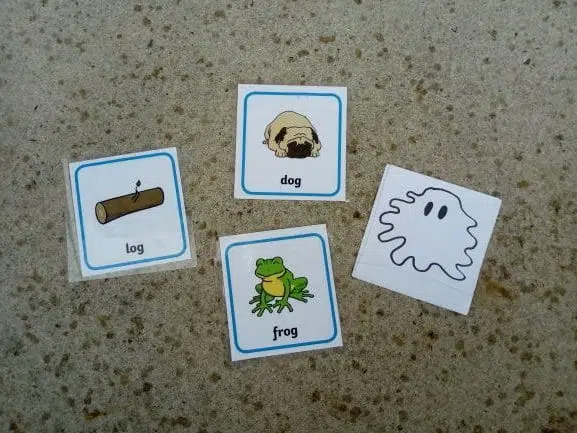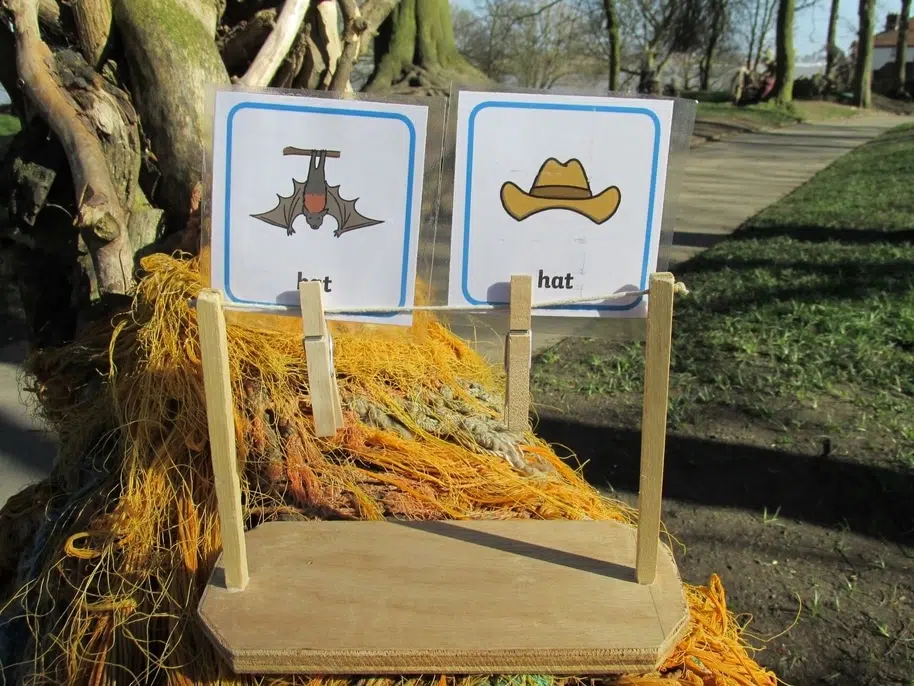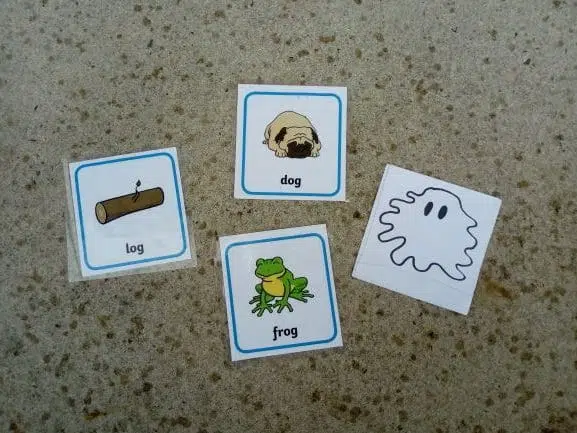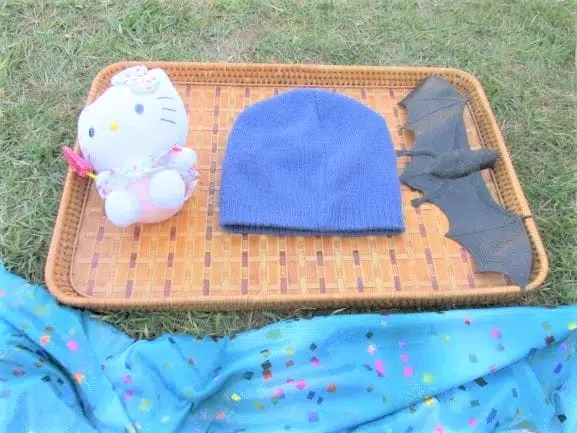There is probably no trickier part of early phonics than teaching children how to rhyme!
Some children just get it straight away, and others take literally years, and can often read fluently before they are able to rhyme successfully.
It is the one area I am asked about the most in early phonics, and so it is the thing I have focused a huge amount of my energy over the last 10 years, teaching children between 3 and 5. There is research that strongly links the benefits that experiencing rhyme has on the development of literacy. (Source)
I have put together this list of 21 rhyming games that I believe are the best way to get children started on this journey of learning how to rhyme. Some are super simple, some a little harder, and some are for practicing their rhyming skills when they’ve achieved it.
The best 21 rhyming activities are:
| Easy Rhyming Games | Chant Rhyming Words To Music |
| Nursery Rhymes (That Rhyme) | |
| The Magical Wizard’s Box | |
| Action Rhyming | |
| Read Rhyming Books (That Repeat A Lot) | |
| Read Rhyming Words Round The Circle | |
| Boo! | |
| Medium Difficulty Rhyming Games | Memory Game |
| Kim’s Game Magic Trick | |
| Robber Game | |
| Match The Rhyming Team Game | |
| Cross The River | |
| Willaby Wallaby Woo | |
| Harder Difficulty Rhyming Games | Odd One Out |
| Rhyming Stone | |
| Feed The Animal | |
| I Spy | |
| Rhyming Dance |

Hundreds of teachers and practitioners have also used these strategies successfully, as I have taught them at my early phonics workshop over the last three years.
I always say a few of the following things to get people started:
- Start as easy as you possibly can when you teach rhyming!
- Begin with children simply joining in with chants, songs and nursery rhyme stories.
- Repeat everything as much as possible!
- Success breeds success!
Right, let’s take a look at the rhyming games themselves. I have broken these rhyming activities down into three stages – rhyming games for beginners, medium-difficulty games, and then games to practice their rhyming skill when they’ve learned how to do it.
There are a few pitfalls to try to avoid, but if you go through these steps, then they will at least be minimized.
The biggest pitfall is children going a bit ‘random.’ For example, when you ask a child, ‘What is the rhyme of cat?’ They often say, ‘cheese,’ ‘dog’, ‘mouse’, or any other weird word association answers.
Try to avoid this randomness at all costs! It is a tricky habit to get out of.
The problem here is doing rhyming games that are too challenging. They then fall back on guessing and making things up.
So go through the following three phases, and children will hopefully be ready to take on rhyme at their level.

Easy Rhyming Games
It’s important to lay the groundwork of rhyme with simple songs, books and also chants.
This is a crucial bedrock that can then be built on later.
Let’s take a look at some great ways to start:
1. Chant Rhyming Words To Music
This is one of the all-time great rhyming games!
It works well because it’s pretty much impossible to go wrong. If the children at least join in, then they will be learning something about rhyme.
Put some pumping music on! I always use something with no words but with a good funky beat. Having no words helps, as the children don’t get confused with what they are saying, and the lyrics in the song.
A good example of a song to use is this:
Get the children to stand up, with the music playing.
Then pick a word that has lots of rhyming words. Something like the word ‘cat’ is a good one to go for.
What you are going to do is chant the word ‘cat’ to the beat of the music. I like to make up ‘actions’ as well. For example, do ‘cat’s whiskers’ in the air as you say ‘cat’. This helps make it as fun and multisensory as possible.
After you’ve said ‘cat’ about four times, change it to another rhyming word. For example, ‘bat’. Go ‘bat, bat, bat, bat’, with some kind of action (like bat wings) to bring it to life.
Just keep going like this, with everyone copying, saying the rhyming words and doing actions.
This activity is great for speech and language, and super as a starting point for rhyme. There is no way of going ‘random’, and it is just a case of joining in.
2. Nursery Rhymes (That Rhyme)
This is an obvious one, but I thought I better include it on this list of rhyming games. Often, the things that are the least like rocket science will have the greatest impact.
Singing simple nursery rhymes is the number one thing to do to set the foundation for rhyming words.
Many nursery rhymes don’t actually rhyme. For example, ‘The Wheels On The Bus’, isn’t actually a ‘rhyme’. That’s not to say there is tremendous value in singing those kind of songs – there definitely is!
But to actually learn and improve your kids’ rhyming skills, you want songs that actually rhyme! Some of these will have great rhyming words:
- Twinkle Twinkle
- Baa Baa Black Sheep
- Incy Wincy Spider
- Wind The Bobbin Up
I could have listed thirty or forty here, but you get the idea.
It’s a great idea to repeat songs they know well lots of times. Plenty of actions and making it fun really helps the process as well.
3. The Magical Wizard’s Box
This rhyming game uses lots of repetitive chanting, a great way to start with rhyme.
Have some kind of old box that is going to be the wizard’s magical box. You could use a picnic hamper, a treasure chest, or cauldron, or anything else like that.
You will also require some kind of magic wand. This could be a bought wand, or something like a stick with some magical material (like wool) wrapped round it will be fine).
One more thing – you need an object that is hidden in the box, and is something that has lots of words that rhyme with it. For example, you could have a toy cat in the box (but secretly – don’t let the children see).
Tell the children that you are going to make a rhyming spell. The box is currently empty (not one hundred percent true!), but if you all do a fantastic spell then something will turn up in the box.
Aim the wand at the box, and get the children to wiggle their ‘magic fingers’ at the box.
Then start chanting!
Once again, pick rhyming words with whatever object you are using in the box.
So, if it is ‘cat’, then chant ‘cat cat cat cat, hat hat hat hat….etc’
If the children can think of their own rhyming words, then that is fantastic! That is exactly what you want.
However, if they can’t come up with a rhyming word, that is absolutely fine (and normal) too. You just make up the words yourself. The important thing is for them to chant them at the box.
When you have done that for a bit, it is time for the big reveal! Dramatically, and very slowly, open up the box! My goodness – there is a cat inside! The element of real magic makes this very exciting.
You could try repeating this rhyming game with different objects. Pick things that have lots of rhymes, e.g. a ‘dog’, a ‘top’, or something else like that.
4. Action Rhyming
One of the simplest rhyming games on this list!
Pick two rhyming words, such as ‘dog’ and ‘frog’.
Get the children to stand up. Tell them we are going to do two actions, one after the other, again and again.
For example, it might be ‘arms up, arms down.’ When you do the first action, say one word. When you do the second action, then try the second word.
So, it might go a bit like (arms up) ‘dog’, (arms down), ‘frog’, (arms up) ‘dog’, etc.
Some other good actions to try are things like the following:
- Hop from one foot to the other
- Jive to the left, jive to the right
- Reach to the left, reach to the right
5. Reading Rhyming Books (That Repeat A Lot)
This is another simple rhyming game or activity that is definitely not rocket science, but I thought I should include it on this list because it is so important for practicing rhyming skills.
Along with nursery rhymes, this is probably the most important on this list to get them started.
Of course, there are so many books that rhyme, but I think the best ones where the rhymes repeat over and over again. This really helps the children to master and predict the rhymes.
A good example of this is ‘The Smartest Giant In Town.’ In this book, the giant repeats a song again and again. Children get to be able to repeat rhymes, such as ‘My shirt’s on a boat / As a sail for a goat.’
Even using an old trick like leaving the last word out is a great one to try.
For example, ‘My belt helped a dog / Who was crossing a…’ (the children hopefully complete the sentence with ‘bog’.)
This is the level of awareness of rhyme you are looking for – the ability to complete a sentence that they already know. Rhyme doesn’t really need to be any harder than this when you are just starting.
Another good book to use this strategy in is Hairy Maclary. The rhyming words repeat over and over again throughout the whole book.
6. Pass The Rhyming Picture Cards Around The Circle
You need some rhyming picture cards for this game. A rhyming picture of a ‘cat’, ‘hat’, and ‘bat’ would be good. It’s good to have lots of the same rhyming pictures, so have about four cats, four hats etc.
The kindergarten children sit in a circle. The simple idea is that the first child in the circle receives a rhyming picture card, and they say what it is, for example, ‘cat’. They pass it to the next person, who also says, ‘cat’. Keep on passing the card around the circle like this! Very easy!
Then start adding more rhyming picture cards. In the end, there will be lots of cards on the go at once, going round and round. This creates a kind of ‘rhyming cacophony’ in the room! It will sound a bit like ‘cat hat bat bat hat cat cat’ – each word repeating over and over.
Great for beginning to internalize rhymes!
7. Boo!
Please do this rhyming game! It is a classic.
Have some rhyming word cards again, and put them in a bag. You also need one picture of a ghost. Put that into the bag as well.

The children sit in a circle. The first child puts their hand into the bag, and pulls out a card. They say what it is, e.g. ‘Cat.’
Then the next child pulls a card out of the bag, and says what it is.
Continue until someone gets the ghost. They are the champion! If you get the ghost, then you are going to say, ‘Boo!’ and try to scare everyone!
Children really enjoy the anticipation and excitement of this game.
Also, it is a great game for them to play by themselves. Show them how to play a couple of times, and then the majority of children will be able to do it by themselves.
Medium Difficulty Rhyming Games
These next rhyming games are just slightly harder than the first ones I described.
However, there is still an emphasis on repetition, and getting children chanting and enjoying rhyming words.
8. Memory Game
For this rhyming game, you need some kind of rhyming pictures again. For example, rhyming picture cards of a ‘log’, ‘dog’, and a ‘frog.’ You need at least one card per child (so you might have four logs, four frogs etc).
The children sit in a circle and give out the cards, one to everyone.
They sit with their rhyming pictures face down on the floor to start with.
The first person in the circle turns over their card, and says what it is – e.g. ‘log.’
Then the next person goes. They turn over their card, but first say the name of the object next to them.
So they might say, ‘log, dog.’
The next person might say, ‘log, dog, frog.’
Keep going like this! It gets much harder for the people sitting further around the circle.
The much harder version of this rhyming game is to say the words but keep the cards face down. Then it is a true memory game (but much trickier).
9. Kim’s Game Magic Trick
Kim’s Game is a very well-known game, but it definitely can be really spiced up by turning it into a magic trick!
The children sit in a circle, and have at least three objects that rhyme – for example, a ‘cat’, ‘hat’, and ‘bat.’

You will also need some kind of sheet and a magic wand.
Get the children to first chant the rhyming objects a few times, and experience the rhymes. It might sound like ‘bat, cat, hat, bat, cat, hat.’
Then cover the objects with the sheet.
Say that you’re going to do a magic trick with the wand, but everyone has to close their eyes or the magic won’t work.
The children hopefully close their eyes, then sneak one object out from under the sheet, put it behind their back, and then say some kind of magic word (e.g. ‘Abracadabra).
Then get them to open their eyes, and take the sheet off. What has vanished?
This game is a fun way of getting rhyming words into a game that they enjoy.
10. The Robber Game
This rhyme game is an alternative way of playing the Kim’s Game Magic Trick activity above.
Have rhyming objects and sheet, but this time one child in the circle is going to be the ‘robber’.
Cover the objects, and the children close their eyes.
The ‘robber’ sneaks over and ‘steals’ an object from under the sheet, and hides it behind their back.
The children open their eyes, and then you take the sheet off. What has been stolen?
11. Match The Rhyming Team
You need two sets of rhyming pictures for this – for example, ‘cat’, ‘bat’ and ‘hat’, and ‘log’, ‘dog’, and ‘frog.’
The kindergarten children stand up. Randomly give out one set to half the children and the other set of cards to the other half.
Stick one picture from each set on the wall on either side of the room – for example, a ‘bat’ on one wall, and a ‘dog’ on the opposite wall.
Say, ‘Go!’
The children are going to try to stand next to the wall where there is a picture that rhymes with their card.
When they’ve had a go, and you’ve ironed out any problems, get them all back in the middle again, and get them to swap cards with others.
Then have another go.
12. Cross The River Game
This is one of the all-time great rhyming games.
Have some kind of pretend river (such as a blue sheet).
You will also need a bag with at least six objects in it. These will be rhyming pairs of objects. For example, you might have a ‘cat’ and ‘bat’, a ‘dog’ and ‘log’, and a ‘fox’ and ‘box’.
The children sit in a circle, with the river in the middle.
Three children are going to go first. They come and stand on one side of the river.
Give them each one of the rhyming pairs of objects – for example, they might get the ‘cat’, ‘dog’ and ‘fox.’
The idea is that you are going to produce an object out of the bag, and if it rhymes with their object, then they are going to cross the river.
Two things to do first. One is to show them the rhyming pairs of objects first. This gives them a fighting chance of getting it right.
Also, sing the song! This goes to the music of ‘She’ll Be Going Round The Mountain,’ but the words are:
You’ll be crossing the river when it rhymes!
You’ll be crossing the river when it rhymes!
You’ll be crossing the river, crossing the river,
Crossing the river when it rhymes!
Sing the song, then pick an object out of the bag. The person that rhymes with it jumps over the river. Then repeat with the other two objects.
After the three children have had a go, repeat the game with three other children. It is good to repeat the game a few times with the same rhyming objects, as the children get good at working out which object goes with what.
Memorizing a few pairs of rhymes is a good springboard for hearing rhymes in words later. There is research describing the positive impacts of experiencing simple rhymes such as these. (Source)
13. Willaby Wallaby Woo
This is one of the ultimate rhyming chants!
The children sit in a circle. Everyone taps there hands on their knees as they chant:
Willaby Wallaby Woo!
An elephant sat on you!
Willaby Wallaby Wee!
An elephant sat on me!
Willaby Wallaby…(insert a rhyming name for a child.e.g. Wayden)
An elephant sat on…(Jayden!)
So, the basic idea is that you pick a child in the circle, and add a ‘w’ to their name. E.g. ‘Lucas’ becomes ‘Wucas.’
Lucas will then lie down in the middle of the circle, having pretended to be squashed by an elephant.
The children all find this hilarious!
Then Lucas goes back to where he was sitting, and repeat with a different child.
I have found this is a rhyming game that children can do, even when they show little rhyming skills up to that point.
Harder Rhyming Games
Now let’s take a look at a range of rhyming games that you can try after children have become confident with lots of the easier rhyme games that I have just looked at.
14. Odd One Out Rhyming Game
This is definitely quite tricky – perhaps one of the most challenging rhyming games on this list.
You basically need at least three rhyming words / objects that all rhyme, and then one that doesn’t.
So, you might have a ‘bat’, ‘cat’, ‘rat’, and ‘tiger’.
All say the names of the rhyming word families together, and see if the children can hear which one doesn’t rhyme.
A top tip for this game – try to have the odd object as something that is really different in sound from the other things.
For example, the above set of objects (bat, cat, rat) have a ‘broccoli,’ or ‘tiger’ or ‘sausage’ as the odd one out. This gives them a fighting chance.
If the odd one out was something like a ‘cot’ that would really confuse some children because it sounds so similar to ‘cat’.
15. Rhyming Stone
This is one of the most fun and exciting rhyming games on this list!
For this, you need some kind of stone that has been decorated in some way. I have painted a stone with weird markings, swirls and patterns.
This is because I tell the children that the stone is from outer space. It has been sent by aliens to turn us into amazing rhymers!
Sit in a circle, and the idea is to pick a rhyming word that you are all going to rhyme with, for example, the word ‘cat.’
The idea is that you will pass the stone around, and everyone will say a word that rhymes with ‘cat.’
However, in reality, this would lead to all sorts of random rhyming words, so a good trick is to chant some ideas before you pass the stone.
Have a practice of chanting, ‘cat, cat, hat, hat, rat, rat, pat, pat, etc’
Then, when you have done chanting rhyming words quite a bit, pass the stone around, and the children only need to say one of the words that you have just chanted.
This gives them a fighting chance to get the rhyming word right, and success breeds success in rhyming!
16. Feed The Animal!
Children love feeding things, making this activity one of their favorite rhyming games!
In this game, you need two boxes (or other containers) that you make look a bit like hungry animals. Have a hole cut out of the boxes for a mouth.
So, for example, you might have a box with a picture of a shark on it. Or a tiger, T-Rex, monster, lion, or anything else.
Put one picture of something that rhymes at the top of one box, and another picture on the other box.
So you might have a shark box, that will eat the rhymes of ‘dog’, and a T-Rex box that will eat the rhymes of ‘cat.’
Have a range of rhyming pictures with the two rhymes on – e.g. ‘cat, bat, hat’, and ‘dog, log, frog.’
The children are just going to try to pop the right card into the correct rhyming box.
17. I Spy
This is of course a classic game, but it is a bit trickier in terms of rhyming than many others.
There is an easier way to play it and a harder way.
The easier way is to find things in the room that have quite long names and change the first sound. For example, you might say, ‘I spy something that rhymes with ‘zelephant.’’ The answer – ‘elephant.’ Or it might be ‘zupboard’ (cupboard).
Longer words actually make it easier.
It is much harder when you try out one syllable words, like ‘I spy something that rhymes with ‘zair’ (‘chair’).
See how they get on. Start with an easy rhyming word, but you can always get harder.
18. Rhyming Dance
This can be quite a simple game that helps improve rhyming skills. But it can be made much harder as well. Just take your pick as to the level of difficulty based on how your children are getting on.
Get the children to stand up, and put on some pumping dance music!
Something like this song (without any words) would be a good one:
Pick a word that has lots of rhymes. Something like ‘cat’ again, would be a good word to try.
Put the music on a pick a simple dance move. Something like arms to one side, then arms to the other.
Chant rhyming words to the music. For example, going, ‘Cat, bat, cat, bat’, as you dance with your arms going one way, then the other.
This is the easy version of the game!
The harder version is where you keep on adding different words and dance moves.
So, you might go, ‘Cat, bat, rat, sat, hat.’ (All linked to five different dance moves).
You can make it as long and tricky as you want.
